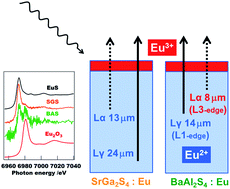Discrepancy in the quantitative oxidation-state analysis of Eu species in sulfide phosphors by K-, L1- and L3-edge XANES spectrometry: choice of absorption edge and measurement mode
Abstract
A quantitative analysis of the oxidation state of europium (Eu) in phosphor samples was performed using X-ray absorption near-edge structure (XANES) spectrometry to investigate the influence of the constituent elements, absorption edge and measurement mode on the evaluated oxidation states. XANES spectra of two kinds of phosphor samples were recorded in fluorescence mode with a Lytle detector at the L1- and L3-edges and in transmission mode at the K-edge. The Eu species in the analysed samples were confirmed to be almost exclusively Eu2+via Eu K- and L1-edge XANES characterization, whereas L3-edge experiments exhibited the presence of Eu3+ up to a content of 35%. In cases wherein the absorption coefficients of constituent elements were higher than the penetration capability of fluorescence X-rays for detection, the quantitative oxidation-state analysis via L3- and L1-edge XANES analysis in fluorescence mode exhibited inconsistent results because of the differences in self-absorption for each emission line. An apparent chemical shift at Eu K-edge was found to be 7.5 ± 0.7 eV, which could provide a more accurate quantitative oxidation-state analysis of a bulk phase because of the large natural width for the K-shell and the penetration capability of an incident X-ray.



 Please wait while we load your content...
Please wait while we load your content...